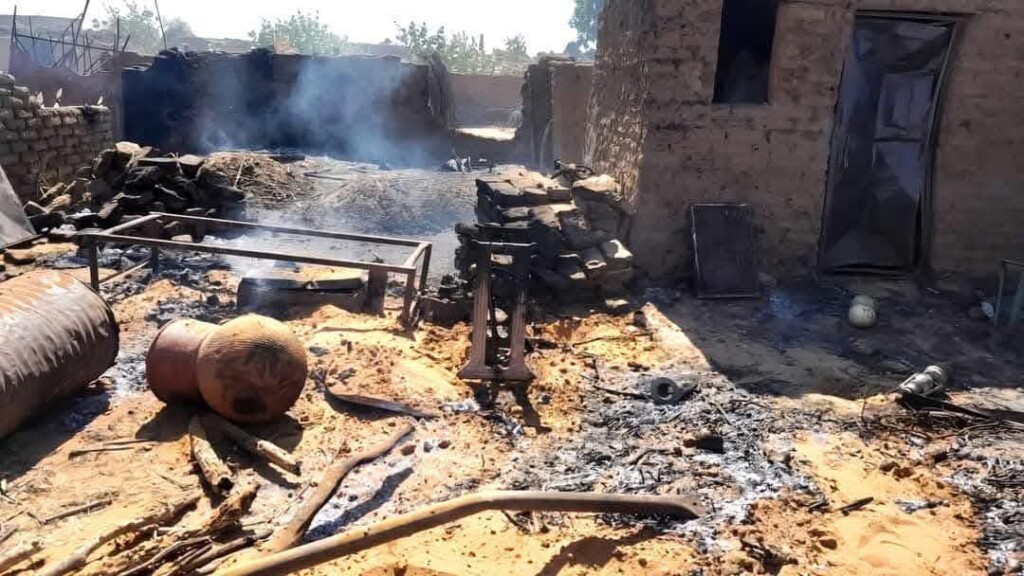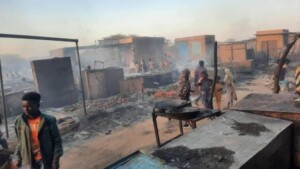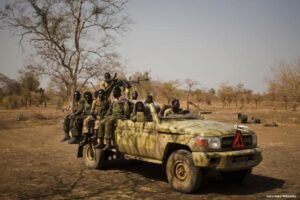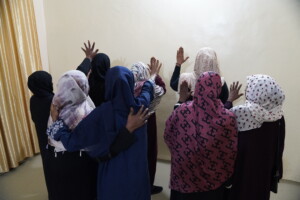Sudan army repels new RSF attack on famine-stricken North Darfur camp

Shelling aftermath in Zamzam camp for displaced people in El Fasher, the capital of North Darfur, December 11 (File photo: Ayin Network / Social media)
The Rapid Support Forces (RSF) yesterday again attacked the Zamzam camp for displaced people south of El Fasher, the capital of North Darfur. The Sudanese Armed Forces (SAF) and the Darfur Joint Force were able to fend off the attack and regain control of the camp. RSF attacks on El Fasher and Dar El Salam continue.
The SAF Sixth Infantry Division Command said in a statement on its Facebook page yesterday that the SAF and the Darfur Joint Force* fighting alongside the army, repulsed the RSF attack on the southwestern parts of the camp.
The Sixth Infantry Division, backed by warplanes and mobilised combatants, were also able to destroy several RSF combat vehicles. The statement said that Zamzam camp is now under army control and free of RSF soldiers.
There was no immediate comment from the RSF about the fighting.
Zamzam lies about 15 kilometres south of the North Darfur capital, home to 1.8 million people, which has been the scene of fierce fighting between the SAF and the RSF since May last year. El Fasher is the last significant holdout against the RSF across Darfur after the paramilitary group occupied the capitals of the four other Darfur states in end 2023.
Yesterday’s attack on Zamzam camp came after days of calm. This largest camp in Darfur is now home to about one million displaced people, after the number of residents doubled since the start of the current SAF-RSF war in April 2023. The displaced have been suffering from malnutrition since the early days of the war. In June last year, “famine thresholds were exceeded” in the camp.
In the early days of December, the RSF launched its first attacks on Zamzam, which forced INGOs operating in the camp to suspend their activities. The camp hospital, set up by Médecins Sans Frontières (MSF) had to be evacuated. Save the Children cited rising cases of severe malnutrition, in the camp, which it described as “the safest place in North Darfur for families and children” up until the RSF attacks in early December.
In November, INGOs had urged the Darfur Joint Force to stop using the camp as one of its bases, warning that this posed a grave risk to the camp residents. The RSF accuses the army and the joint force of turning Zamzam camp into a military base and using the displaced as human shields.
Earlier this month, the RSF launched new attacks on the camp. Last week, they destroyed large parts of the main camp market.
Minni Minawi, the governor of Darfur and leader of the Sudan Liberation movement faction that is fighting the RSF alongside the army, reported on his X account that the attack last week resulted in the killing of 25 people and the wounding of 47 others. Nine people were abducted. Nearly 40 homes, 8,000 shops, and several mosques and schools were torched. Eleven water tanks were damaged and hundreds of vehicles were stolen from the camp.
Butcher Hatem Abubakr accused the RSF of stealing and burning more than 1,600 heads of cattle, leading to a complete collapse of the meat trade in the camp. According to estimates from the Zamzam camp’s Chamber of Commerce, the financial losses reach about $25 million.
The Human Sciences Laboratory at the US Yale School of Public Health in the confirmed, in a report based on satellite images, that half of the Zamzam camp market was burned last week. The report indicated that 13 villages, including Salouma and Ammar Jadeed, also burned down as a result of the attacks.
More RSF attacks
Speaking to Radio Dabanga, sources in El Fasher reported tthat the RSF renewed their heavy artillery shelling on the city from several directions yesterday morning, while warplanes continued to bombard areas controlled by the RSF inside and around the state capital.
On Sunday, the command of the Sixth Infantry Division in El Fasher accused the RSF of bombing Mellit station and neighbouring residential areas in El Fasher, which led to the killing of 10 people.
The command said that the Sudanese Air Force launched five airstrikes on areas controlled by the RSF in the capital city and destroyed an RSF base in the east of the city.
The El Fasher Resistance Committees reported on its Facebook page that the Dar El Salam market, southeast of El Fasher, was attacked by militiamen on Sunday. “Consumer goods, medicines, and Starlink satellite internet devices were stolen.”
The Emergency Response Room of Dar El Salam said that residents of 10 villages in the area have fled to the town within a week following RSF attacks.
* The Darfur Joint Force was formed in June 2022, as agreed on in the 2020 Juba Peace Agreement (JPA), to protect the people in the region. The force was made up of fighters of the Sudan Liberation Movement faction headed by Darfur Governor Minni Minawi (SLM-MM), the JEM faction led by Finance Minister Gibril Ibrahim (JEM-GI), and several small rebel groups that signed the JPA. These movements renounced their neutrality in November last year and are now fighting the RSF alongside the Sudanese army. Since then, Sudanese media speak about the Joint Force of Armed Struggle Movements, while the group’s logo on their X and Facebook accounts says Sudanese Joint Force (and in Arabic Sudanese Joint Forces).











 and then
and then